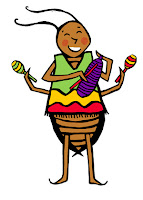 |
| A contemporary corrido song sheet of La Cucaracha issued during the Mexican Revolution. (source: wikipedia) |
The refrain reads:
La cucaracha, la cucaracha
Ya no puede caminar
Porque no tiene, porque le falta
Marijuana que fumar.
(The cockroach, the cockroach
Now he can't go traveling
Because he doesn't have, because he lacks
Marijuana to smoke.)
And the verse continues:
Ya la murio la cucaracha
Ya la lleven a enterrar
Entre cuatro zopilotes
Y un raton de sacristan.
(The cockroach just died
And they carried him off to bury him
Among four buzzards
And the sexton's mouse.)
The origins of the song are obscure, some versions refer to the Moorish wars in Spain, which concluded with the conquest of the Moorish kingdom of Granada by Ferdinand and Isabella in 1492. Probably the song itself doesn't go back that far, but in an 1818 book, according to one source, the Mexican writer Jose Joaquin Fernandez de Lizardi claimed the song was brought to Mexico from Spain by a captain of marines. Some lyrics of the song are commemorating 19th-century conflicts in both Spain and Mexico, but verse production didn't really increase until the Mexican revolution of 1910-1920. So many stanzas were added by partisans on all sides during this period that today, despite its Spanish origin, the song is associated mostly with Mexico. Some say the mentioning of marijuana was directed at the dictatorial Mexican president Victoriano Huerta (ruled 1913-1914), ridiculed by his many enemies as a drunk and dope fiend who lived only for his daily weed. Other claim that la cucaracha refers solely to Pancho Villa, a famous bandido/revolutionary general. Whatever the origins and meaning of the song, La Cucaracha is the Spanish equivalent of Yankee Doodle — a traditional satirical tune periodically fitted out with new lyrics to meet the needs of the moment. (excerpted from this source)
The song's verses fit a traditional melody separate from that of the refrain but sharing the refrain's meter (either 5/4 or 6/4). The melody and the refrain are instantly ear catching and the song has been performed successfully in various settings. Here's a traditional Mexican performance of La Cucaracha by a mariachi trio
 |
| Original film poster (1934) |
Maybe the exposing of the song on screen helped La Cucaracha to gain popularity with an American public. Fact is that many American popular bands and performers included the song in their repertoire from about the same time as the mentioned films were released. One of the first performers to include La Cucaracha and record the tune with lyrics in English (- different from the Mexican versions) was Louis Armstrong, who recorded the song for Decca in October 1935 (De 580)
Other popular performers also included La Cucaracha in the repertoire, among them was Benny Goodman, who performed the song with his orchestra in a "Camel Caravan" broadcast August 31, 1937. Also Glenn Miller and his orchestra performed the song in two CBS "Chesterfield Show" broadcasts, January 22 and March 25, 1941. Woody Herman and his orchestra recorded a mambo version of the tune for Capitol in 1954 (CAP EAP2-560), and on January 23, 1952 Charlie Parker and his quintet used La Cucaracha as a vehicle for a stunning bop improvisation, recorded by Mercury (Mercury/Clef 11093)
In Europe, La Cucaracha also became popular during the 1930s. An early example is the recording by Lud Gluskin and his Continental Orchestra for French Columbia (Co 2952-D) (1934)
There was also made recordings of the song by accordionists in France with lyrics in French, an example of a musette inspired version was recorded by accordionist Adolphe Deprince mid-30s, available at YouTube, here - However, my favorite version of La Cucaracha recorded in France is by Mexican female vocalist and actress Lina D'Acosta featuring Oscar Alemán for the Pathé label, Paris March 5, 1935.
 |
| La Cucaracha_ Pathé (PA 531) |
 |
| Lina D'Acosta |
 |
| Cockroach cartoon |
---
Jo
keepitswinging.domain@gmail.com
 Retrospect
Keep Swinging (old)
Oscar Aleman Choro Music Flexible Records Hit of the Week-Durium Friends of the Keep Swinging blog Keep Swinging Contributions
Retrospect
Keep Swinging (old)
Oscar Aleman Choro Music Flexible Records Hit of the Week-Durium Friends of the Keep Swinging blog Keep Swinging Contributions

No comments:
Post a Comment